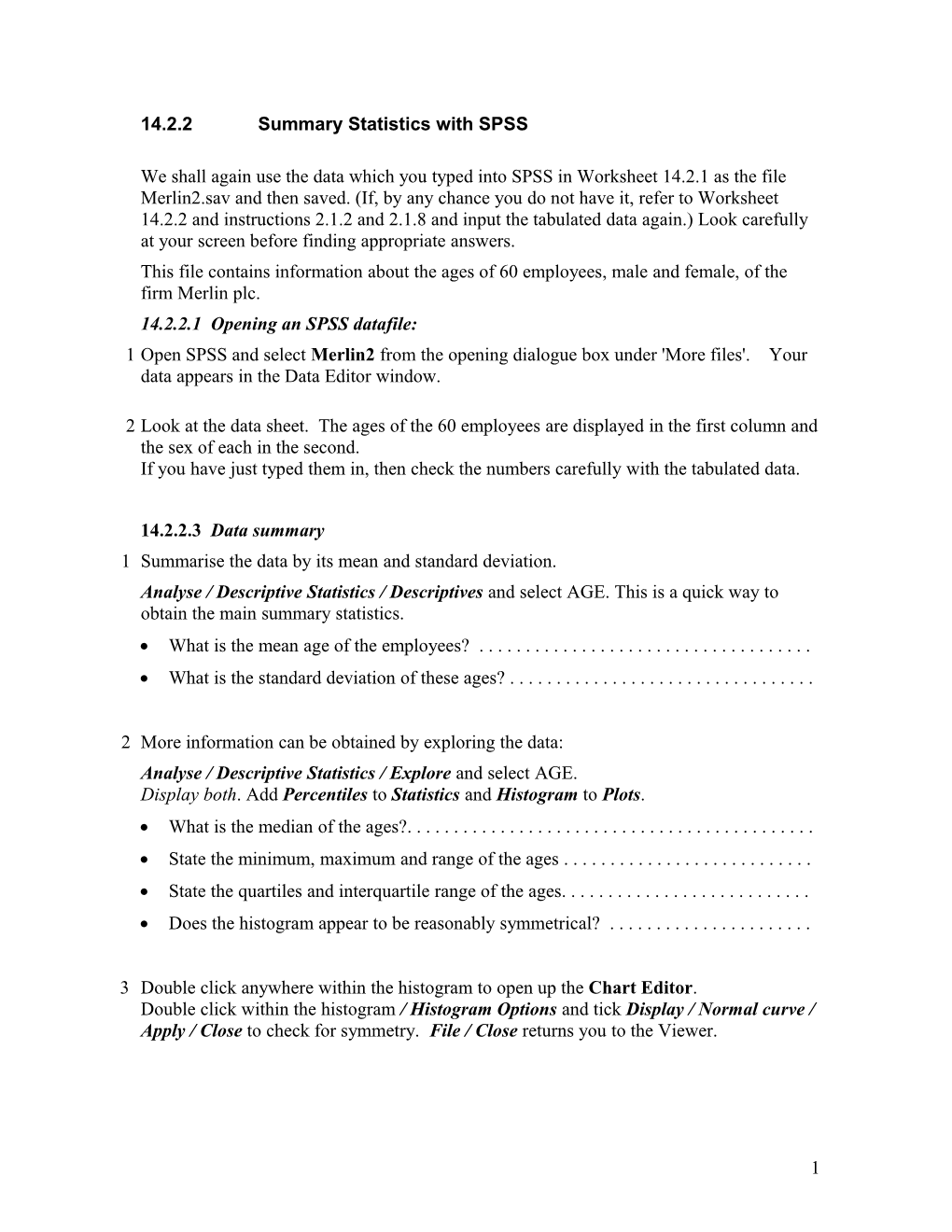14.2.2 Summary Statistics with SPSS
We shall again use the data which you typed into SPSS in Worksheet 14.2.1 as the file Merlin2.sav and then saved. (If, by any chance you do not have it, refer to Worksheet 14.2.2 and instructions 2.1.2 and 2.1.8 and input the tabulated data again.) Look carefully at your screen before finding appropriate answers.
This file contains information about the ages of 60 employees, male and female, of the firm Merlin plc.
14.2.2.1 Opening an SPSS datafile:
1Open SPSS and select Merlin2 from the opening dialogue box under 'More files'. Your data appears in the Data Editor window.
2Look at the data sheet. The ages of the 60 employees are displayed in the first column and the sex of each in the second.
If you have just typed them in, then check the numbers carefully with the tabulated data.
14.2.2.3 Data summary
1Summarise the data by its mean and standard deviation.
Analyse / Descriptive Statistics / Descriptives and select AGE. This is a quick way to obtain the main summary statistics.
- What is the mean age of the employees? ......
- What is the standard deviation of these ages? ......
2More information can be obtained by exploring the data:
Analyse / Descriptive Statistics / Explore and select AGE.
Display both. Add Percentiles to Statistics and Histogram to Plots.
- What is the median of the ages?......
- State the minimum, maximum and range of the ages ......
- State the quartiles and interquartile range of the ages......
- Does the histogram appear to be reasonably symmetrical? ......
3Double click anywhere within the histogram to open up the Chart Editor.
Double click within the histogram / Histogram Options and tick Display / Normal curve / Apply / Close to check for symmetry. File / Close returns you to the Viewer.
14.2.2.3 Comparing groups of data
1Check that the number in each group is correct:
Analyse / Descriptive Statistics / Frequencies. Select SEX as the variable.
Charts / Piecharts.
Double click anywhere within the piechart produced to open up the Chart Editor. Double click within the piechart, or on the legend, to open Properties / Data value labels. Select Frequency Sex of Employee / Percent / Apply / Close. Select the icon for Data ID mode on the tool bar and click on each sector.
What percentage of the employees are male? ......
2 Compare the two groups:
Analyse / Compare means / Means Move AGE into the Dependent List and SEX into the Independent List. From Options add Median to the Cell Statistics.
- State the median for each group......
- State the mean and standard deviation for each group......
- Compare the median with the mean for each group ......
......
3Looking for a more detailed comparison, Explore can be used on each group:
Analyse / Descriptive Statistics / Explore Move AGE into the Dependent list and Sex into the Factor list. Plots / select Boxplots / Factor levels together.
- For which sex are the ages higher, on average? Give two reasons?......
......
- For which sex are the ages more spread out, on average? Give two reasons? ......
- Do the boxplots illustrate the same results? ......
4Print out your output:
In the Viewer window File / Print / all
1
